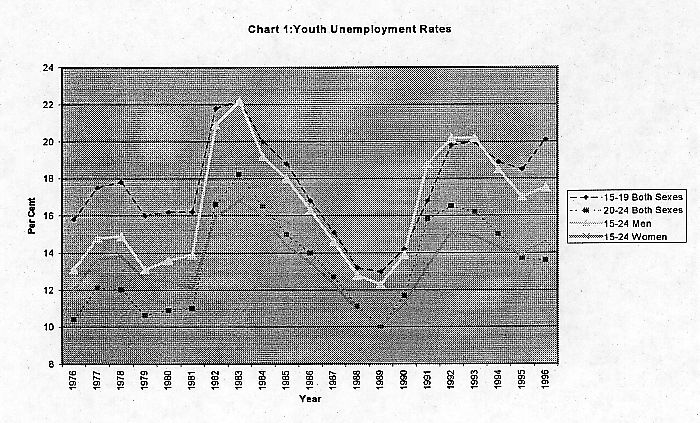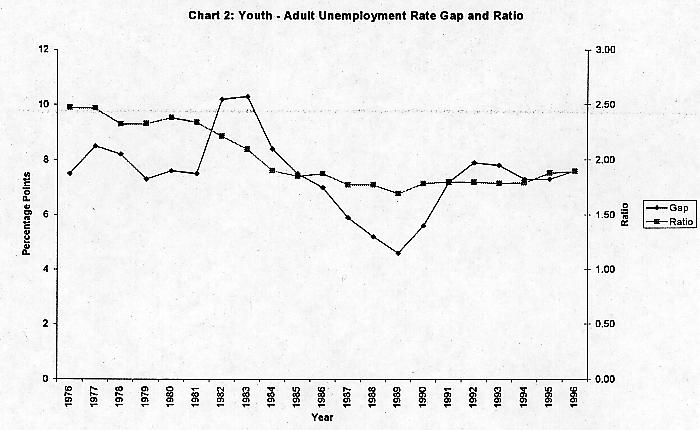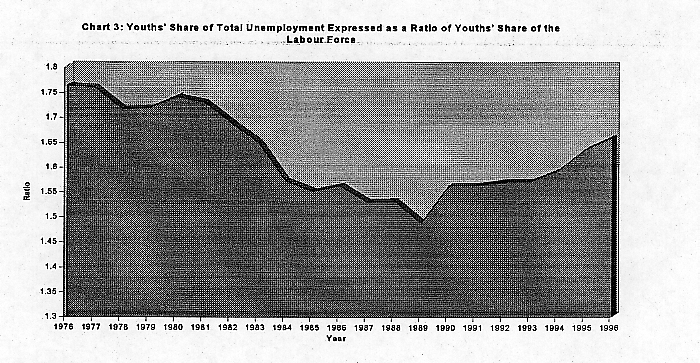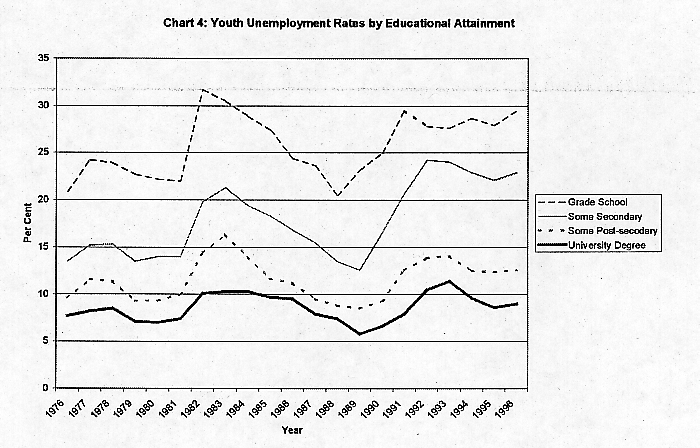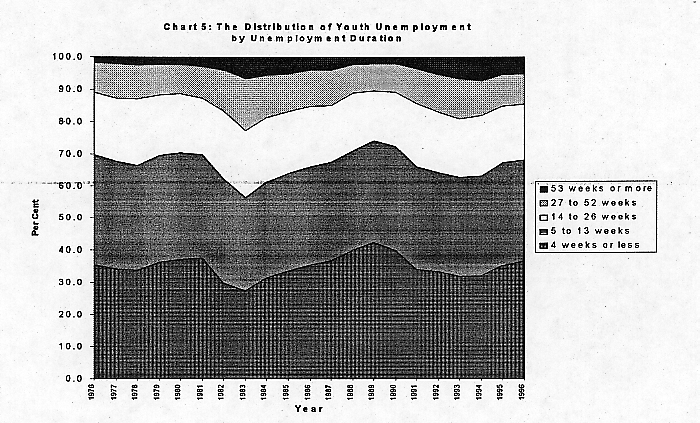BP-448E
YOUTH UNEMPLOYMENT TRENDS
Prepared by: TABLE OF CONTENTS
YOUTH UNEMPLOYMENT TRENDS Youth unemployment has been, and continues to be, a perennial problem for policy-makers in Canada and many other OECD countries. The transition from school to work is difficult for many young people, as evidenced by the relatively high rates of unemployment experienced by individuals 15 to 24 years of age, the official age category defined as "youths" by Statistics Canada. The school-to-work transition has become more difficult of late as a result of the low rate of job growth following the 1990-91 recession. It has become particularly difficult for those who do not possess the necessary education and skills demanded in today’s labour market. This paper provides an overview of youth unemployment trends during the period 1976 to 1996. Youth unemployment is relatively higher than adult unemployment for several reasons, of which two are key. First, seniority in the Canadian labour market is an important consideration for employers who decide to reduce employment levels; thus, according to gross flow data, employed youth are more likely to become unemployed than are adults. Throughout the period 1985 to 1994, it is estimated that flows from employment to unemployment accounted for at least one-third of the gap between youth and adult unemployment rates.(1) The other main contributor is the higher tendency of young employed workers to leave the labour force, thereby reducing the size of the youth labour force relative to the number of unemployed youth. This weaker attachment to the labour force is estimated to be the most significant gross flow contributor to the gap between youth and adult unemployment rates. The youth unemployment problem in this country is often discussed as if "youth" were a homogeneous group. In reality, there are wide differences among 15 to 24 years olds. Chart 1 highlights some of these differences for the year 1996. For example, teenagers typically have higher rates of unemployment than youths aged 20 to 24. Between 1990 and 1996, the average annual unemployment rate differential between these two age groups was 3.7 percentage points, unchanged from the previous decade.
As is also evident from Chart 1, young women tend to experience lower rates of unemployment than young men. The average annual unemployment rate differential between young men and women during the period 1990 to 1996 was 4.1 percentage points. This was roughly 40% higher than the average annual unemployment rate differential (2.9 percentage points) in the 1980s. There are also substantial differences in youth unemployment rates across the country. For example, in 1996 Newfoundland’s youth unemployment rate was 29% or 1.8 times the national rate for youth of 16.1%. Saskatchewan and Alberta, on the other hand, registered the lowest regional rate of unemployment in that year (12.2%), roughly three-quarters of the national rate. Interestingly enough, these same rankings existed at the beginning of the 1980s, although Ontario was registering the lowest differential by the end of the 1980s.
There is no doubt that the seriousness of Canada’s youth unemployment problem was diminishing before the onset of the 1990-91 recession. Between the mid-1970s and the end of the 1980s, labour market conditions among youths had improved relative to those of their adult counterparts. This trend is presented in Chart 2, which displays two measures of relative unemployment among youth: one expressing the youth unemployment rate as a ratio of the adult rate, and one showing the gap between youth and adult unemployment rates. Both measures, especially the former, show a downward trend for youth unemployment until the 1990-91 recession. The latter measure widened in response to the recessions in 1981-82 and 1990-91, making it clear that youth unemployment is more cyclically sensitive than adult unemployment. As noted previously, firms heavily favour employees with seniority when adjusting employment; as a result, youths tend to be laid off first and rehired last. Youths’ share of total unemployment, which in 1976, accounted for almost one-half of total unemployment, has also declined over the years. Last year, their share of total unemployment was about 27%. However, when measuring the incidence of youth unemployment it must be taken into account that the size of the youth labour force also declined during this period. Chart 3 depicts a downward trend in youths’ share of unemployment relative to their share of the labour force after 1976 and until the 1990-91 recession, when the trend was reversed.
Today, many Canadians believe that long-term job prospects for youths are declining and that today’s young workers are doing more poorly in the labour market than past generations. To some extent, this is true, but the situation depends largely on the skills and education of young workers; the impact of education on the transition from school to work cannot be overstated. Today, proportionately more youths are pursuing higher levels of schooling than in the past: in 1989, the proportion of youths attending school was 51.9%; in 1996, it was 60.4%. Moreover, despite the fact that the size of the youth population declined during this period, the numbers enrolled in post-secondary education increased.(2) While this trend is due, in part, to poor labour market conditions, it should also be noted that many young people today recognize the growing importance of education and skills in the labour market. There is no doubt that the level of education and training necessary to acquire the skills demanded in the labour market today are higher, on average, than in the past. This trend is expected to continue in the future.
Chart 4 illustrates the importance of education in the context of youth unemployment; it shows that youths with more schooling consistently exhibit lower rates of unemployment than their less educated counterparts. In fact, youths with a university degree appear to be as well off today as their counterparts 20 years ago. Despite the steady upward trend in the aggregate unemployment rate during this period, the unemployment rate among young individuals with a university degree in 1996 was similar to that in 1976. The unemployment rate among youths with a university degree declined relative to the overall youth unemployment rate between 1976 and 1996. In contrast to the situation for highly educated youths, however, unemployment among less educated youths has increased dramatically in the last 20 years. As illustrated in Chart 4, the unemployment rates of youths with grade school and some high school have increased by 9 percentage points in that period. The importance of education is also reflected in young workers’ earnings. According to data from the National Graduate Survey, real median full-time earnings of 1990 graduates with a bachelor’s degree were $32,000 two years after graduation, slightly higher than the $31,900 reported for 1982 graduates in 1984. On the other hand, median real full-time earnings of youths without a post-secondary degree or diploma declined from $23,900 to $22,600 over the same time period.(3) Irrespective of educational attainment, it should be noted that young workers have witnessed a decline in real earnings since the beginning of the last decade; this is partly attributable to the increase in the proportion of young people who work part-time. While recent research suggests that proportionately fewer young workers are currently employed in the so called "good job" sector than was the case a generation ago, it should be noted that, at least until now, the extent of the concentration in the "bad job" sector has usually weakened with age. In other words, many young workers appear able to make the transition into the primary labour market as they progress through their 20s.(4) Finally, Chart 5 shows the distribution of youth unemployment by the duration of unemployment. In addition to the expected cyclical nature of this distribution - that is, longer unemployment spells during periods of economic weakness - these data suggest that, with the exception of long-duration spells of unemployment, the length of unemployment is distributed among youths today in much the same way as 20 years ago. In both 1976 and 1996, roughly two-thirds of all unemployed youths had a spell of unemployment lasting less than 14 weeks. At the other end of the distribution, in 1996 5% of all unemployed youths were unemployed for more than one year, a proportion about three times higher than for 20 years earlier. The increase in the proportion of long-term unemployed youths is undoubtedly partly linked to the structural unemployment problems facing unskilled workers of all ages in today’s labour market.
As indicated at the outset, youth unemployment has been on the policy agenda of the federal government for a long time. Its prominence today as a policy issue stems, in part, from the absence of job growth among youths and the fact that their unemployment rate remains relatively high compared to that of the nation as a whole. There is no question that the job prospects facing young workers today are relatively worse than those prior to the 1990-91 recession. The federal government has a long-standing acquaintance with youth-specific labour market adjustment programs.(5) In addition to summer employment programs, unemployed youth aged 18 to 24 have an opportunity to gain work experience and job-related skills under the Youth Service Canada program. In addition to weekly payments, participants who complete the program receive a grant of at least $2,000, which can be used for job search, returning to school, starting a business or paying off a student loan. The Youth Internship program is intended to provide unemployed youths (normally under the age of 30) with opportunities for work experience in partnership with the private sector, not-for-profit organizations and community agencies. Work experience opportunities are created in many areas including, for example, science and technology, the environment, international trade and international development, and, most recently, the federal public service. In the Speech from the Throne on 23 September 1997, the government promised to work in several ways to help youths make a smoother transition from school to work. This initiative is expected to include, for instance, extending and broadening internship programs, augmenting summer job opportunities, participating in the development of a nation-wide mentorship program, and developing and expanding community-based employment programs for disadvantaged youths (for example, establishing multi-purpose Aboriginal youth centres). There is no doubt that many youths are experiencing serious difficulties in making the transition from school to work, a process in which education plays a very vital role. While highly educated youths do not appear to be worse off than in previous generations, their less educated counterparts do. Compared to youths 20 years ago, less educated youths are experiencing much higher levels of joblessness. Those in this group undeniably warrant the special attention of policy-makers, since the labour market problems confronting them are primarily structural in nature and may persist into adulthood if not properly addressed today. Betcherman, Gordon and Norm Leckie. Youth Employment and Education Trends in the 1980s and 1990s. Working Paper No. W03. Canadian Policy Research Networks, February 1997. Canadian Youth Foundation. Youth Unemployment: Canada’s Hidden Deficit. 1995. Kerr, Kevin B. Youth Unemployment in Canada. CIR 82-4E. Parliamentary Research Branch, Library of Parliament, Ottawa. OECD. "Growing into Work: Youth and the Labour Market over the 1980s and 1990s." Employment Outlook, Chapter 4, July 1996. Statistics Canada. "Youths and the Labour Market." Labour Force Update, Spring 1997. (1) Human Resources Development Canada, Applied Research Bulletin, Vol. 2, No. 2, 1996, p. 4. (2) Statistics Canada, "Youths in the Labour Force," Labour Force Update, Spring 1997, p. 14. (3) Human Resources Development Canada, "Youth Employment Diagnostique," unpublished. (4) G. Betcherman and N. Leckie, Youth Employment and Education Trends in the 1980s and 1990s, Canadian Policy Research Networks, 1997, p. 24-5. (5) Of course, youths also have access to the initiatives available under Part II of the Employment Insurance Act. |
